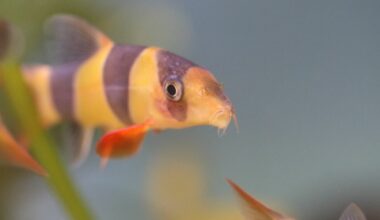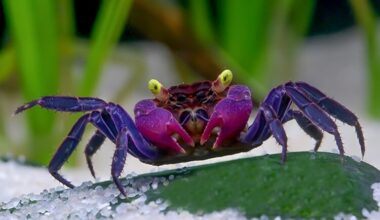If you’re seeking an addition to your aquatic family that exudes both beauty and charm, then look no further than the Doctorfish Tang. Known for its striking appearance and captivating behavior, this species is a popular choice among saltwater aquarists.
While the Doctorfish Tang possesses undeniable beauty and charm, it is essential to understand its specific care requirements. Maintaining a healthy and thriving environment for this species involves providing appropriate tank size, water quality, and diet. This care guide will equip you with the necessary knowledge and insights to ensure the well-being of your Doctorfish Tang, promoting its long-term health and happiness.
Get ready to enhance your saltwater aquarium with the mesmerizing allure of this remarkable marine creature.
Table of Contents
Species Summary
The Doctorfish Tang, or Acantharus chirurgus, gets its name from the “scalpels” near the caudal peduncles. This feature gives the fish a defense protocol against predators and other dangers. Sometimes, you may hear the Doctorfish Tang referred to as a Surgeonfish!
Doctorfish Tangs stand out from other tangs with their color-changing bodies and vertical stripes. They live among the reef with the other Surgeonfish breeds. Doctorfish Tangs stay around the Atlantic Ocean from Massachusetts to Brazil. Some of these fish live off the west coast of Africa or the Mediterranean Sea.
Doctorfish Tangs spend most of their time up to 82 feet below the surface. They are happy alone, in pairs, or loose groups. The juveniles consume parasites and molted skin on green turtles while filling their diets with microalgae like the adults.
Author Note: These fish have some territorial behaviors. Try to acclimate new fish to their homes in a larger aquarium. Stay aware of negative behaviors to keep everyone healthy and stress-free.
Appearance
Doctorfish Tangs have the typical oval-like body of most other Surgeonfish. They have bluish-gray bodies, though some are a darker brown. Doctorfish tangs have faint vertical stripes on their sides for a unique appearance.
The Doctorfish Tang has blue details near their caudal, dorsal, and anal fins. The scalpels on the side act as a defensive mechanism against predators in the wild. A blue ring encircles these features for a brighter section.
Every Doctorfish Tang has iridophores in its scales for a color-changing feature. These pigments control how much your fish will reflect the light and water around them. Open scales make the Doctorfish Tang appear bluer and brighter. When they close, the Doctorfish Tang appears a darker brown.
Author Note: Doctorfish Tangs use their color-changing abilities to communicate with the schools around them. They can indicate the fish’s mood when in a tank. If you notice excessive dark brown colorations, your Doctorfish Tang may feel more stressed.
The blue highlights near the fins, scalpels, and vertical bars make the Doctorfish Tang stand out among other Surgeonfish. The slashes from the scalpels will hurt. You must keep your hands protected when handling these fish!

Lifespan
Most Doctorfish Tangs have a lifespan of between 16 and 27 years. They will live longer if they have a stress-free environment and lifestyle. Some scientists believe these fish can reach a lifespan of as long as 43 years!
Doctorfish Tangs reach their highest lifespans when living in the wild. They typically have shorter lives in an aquarium in your home. Most owners agree that these fish live around seven to eight years in these environments.
Average Size
Doctorfish Tangs have an average size anywhere from 10 to 11 inches. In adulthood they can reach as long as 15.4 inches in length and weigh around 11 pounds.
Juvenile Doctorfish Tangs are much smaller than their adult counterparts. These fish only reach 3.9 to 4.7 inches in length on average. The Doctorfish Tangs will likely only be around one inch long when you buy them.
Doctorfish Tang Care
Doctorfish Tangs need plenty of space to swim in their tanks. They love exploring in the daylight hours, and sleep among the corals and sand at night. Sometimes, you can find these fish in caves where they can hide from predators and other fish.
Add nooks and other structures to your tank to give them better hiding spots in your aquarium. Make sure these pieces can fit the entire length of your adult Doctorfish Tangs. Your fish will live stress-free lives when feeling safe in your aquarium. They should also have wide-open spaces where they can swim throughout the day.
Author Note: You must look out for disease and sickness when caring for your Doctorfish Tangs. These fish need a comfortable environment to avoid infection and other related illnesses. The happiest fish will last you for years to come!
Keep your Doctorfish Tangs familiar with what they can expect in your aquarium. Only introduce fellow inhabitants it knows and keep the decor stable. The water conditions must also maintain a sense of consistency. Overall, these fish are relatively easy to have in your home.
Tank Size
If you only have one Doctorfish Tang, the recommended tank size is at least 100 gallons. A school of these fish requires you to install a much larger tank! Everyone needs space to avoid aggressive behaviors and high-stress environments.
Water Parameters
- Water Temperature: 72 to 80°F
- pH Levels: 6.0 to 8.0
- Water Hardness: 6 to 10 dKH
- Specific Gravity: 1.020 to 1.025
Tank Setup
Doctorfish Tangs need a tank with consistent water levels and some movement. They prefer to swim in the wild, pushing themselves against the ocean’s current. Keep your Doctorfish Tangs active by adding minimal movement to your tank.
Add sand to the bottom of the Doctorfish Tang’s tank to give them space to explore. They enjoy spending time near the bottom of the ocean floor searching for food. Allow them space to engage in the same behaviors in your tank.
Finally, set up a bedroom towards the middle of the tank. This area is where you can set up your caves and reefs for added hiding spots.
Author Note: Remember, do not overfill your aquarium with props, as the fish need ample swimming space.
Are Doctorfish Tangs Reef-Safe?
Yes, Doctorfish Tangs are reef safe! They have teeth that allow them to pull microalgae away from rocks and coral. You do not have to worry about the Doctorfish Tangs eating your polyps. The fish and the coral will thrive in your tank!
Doctorfish Tangs sometimes go toward mussels or clams. They like to consume small crustaceans you may have in your aquarium. Provide ample food to your fish to avoid these problems!
Common Possible Diseases & Prevention
Although not very common, Doctorfish Tangs end up in restaurant menus but we would recommend to stay away from this option and try the tuna instead. Doctorfish Tangs are known for causing ciguatera poisoning to people who eat them. The dinoflagellates Doctorfsih eat lead to toxic exposure to this substance.
Doctorfish Tangs are prone to scale infections on any parts of their bodies. They do not produce a thick mucus coat as seen on other similar fish. Monitor your Doctorfish Tangs for any unnatural behaviors or scale deformations to prevent these infections from worsening.
Some of the most common scale infections your fish could encounter include Marine Ich and Marine Velvet. You can treat these conditions with medical care or copper pills. Do not overextend your use of these treatments, as they can prevent microfauna consumption.
Author Note: Doctorfish Tangs can sometimes encounter parasites in an aquarium tank. You will not know if your fish have these invaders until you have them in your home. Purchase Neon Gobies or krill shrimp to keep these parasites out of your tanks and away from Doctorfish Tangs.
Food & Diet
Doctorfish Tangs’ are omnivorous and they love to feed on microalgae, so keep ample greens in their diets. Again, these fish’s teeth make it easy to eat algae stuck to rocks and coral.
You can supplement a Doctorfish Tang’s diet using Nori or seaweed. Provide them these ingredients two or three times a week to avoid having a hungry fish in your tank. Another option for supplementation for your Doctorfish Tang is Chaetomorpha.
Doctorfish Tangs require some protein since they are omnivores. These ingredients help them maintain their lifestyle and activate their metabolisms. Use fish food, brine shrimp, krill, or mussels to supplement their diets. Doctorfish Tangs swallow their meals whole, so provide them with small portion sizes.
Author Note: If nutritional disorders occur, Doctorfish Tangs could get sick with color loss and LLD (lateral line disease) so make sure to supplement their diet with Vitamin C.
Behavior & Temperament
Doctorfish Tangs sometimes live among schools of fish in the wild. They comb through the sand searching for food together. Juvenile Doctorfish Tangs are cleaners in their base environments!
Adult Doctorfish Tangs need cleaning when they get older. The scales change colors to show where they have parasites or algae growing on their bodies. Add gobies or krill shrimp to your tank to remove these areas from their scales.
A small aquarium will not accommodate a host of Doctorfish Tangs in your tank. Only a massive tank will allow you to keep more than one, otherwise, they begin to act territorial in a home-based environment.

Doctorfish Tang Tank Mates
Doctorfish Tangs do not get along with one another, but you can add other fish to your aquarium. These fish, for the most part, get along with other Acanthurus varieties.
Some available options for your tank include:
- Angelfish like the Emperor Angelfish
- Clownfish
- Gobies (maybe Neon Goby or Mandaring Goby)
- Triggerfish such as the Picasso Triggerfish and Clown Triggerfish
- Damselfish
Try to avoid adding other algae eaters to your aquarium. You may risk your Doctorfish Tang becoming territorial over their food. You can prevent these behaviors by providing ample meals to all the fish in your home aquarium.
Breeding
The Doctorfish Tang has virtually no difference between a male and a female. This consideration makes it difficult to try to breed these fish in a home environment. As of the time of this writing there have not been any records of Doctorfish Tangs being bred in captivity.
Doctorfish Tangs typically breed in the wild. They gather in groups at night, allowing fertilized eggs to drop before hatching. The larvae become part of the plankton, eventually turning into juvenile Doctorfish Tangs. They become mature and ready to breed themselves when they are nine months old.
It is best to buy a juvenile Doctorfish Tang for your home aquarium. These fish will live longer, and you do not have to worry about as many pre-existing health conditions. Doctorfish Tangs always provide a beautiful addition to any tank in your home!
Wrapping Up
In conclusion, caring for a Doctorfish Tang can be an immensely rewarding experience for any saltwater aquarist. As we’ve explored in this guide, this remarkable species offers a combination of beauty, charm, and captivating behavior that make it a true gem in any marine aquarium.
By providing the right environment and meeting its specific care requirements, you can ensure the well-being of your Doctorfish Tang and promote its longevity and happiness. From maintaining proper tank size and water quality to offering a suitable diet, every aspect of its care contributes to its overall health and vitality.
We hope you enjoyed this care guide and don’t forget to keep us in the loop, maybe even tag us on Facebook with one of your good looking aquarium photos 😉
Happy fishkeeping!

